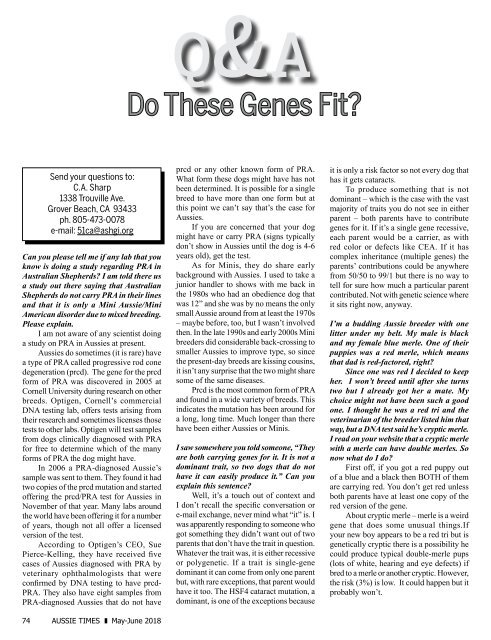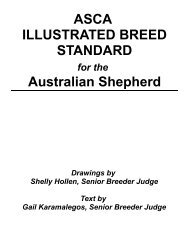2018 May June
You also want an ePaper? Increase the reach of your titles
YUMPU automatically turns print PDFs into web optimized ePapers that Google loves.
Q&A<br />
Do These Genes Fit?<br />
Send your questions to:<br />
C.A. Sharp<br />
1338 Trouville Ave.<br />
Grover Beach, CA 93433<br />
ph. 805-473-0078<br />
e-mail: 51ca@ashgi.org<br />
Can you please tell me if any lab that you<br />
know is doing a study regarding PRA in<br />
Australian Shepherds? I am told there us<br />
a study out there saying that Australian<br />
Shepherds do not carry PRA in their lines<br />
and that it is only a Mini Aussie/Mini<br />
American disorder due to mixed breeding.<br />
Please explain.<br />
I am not aware of any scientist doing<br />
a study on PRA in Aussies at present.<br />
Aussies do sometimes (it is rare) have<br />
a type of PRA called progressive rod cone<br />
degeneration (prcd). The gene for the prcd<br />
form of PRA was discovered in 2005 at<br />
Cornell University during research on other<br />
breeds. Optigen, Cornell’s commercial<br />
DNA testing lab, offers tests arising from<br />
their research and sometimes licenses those<br />
tests to other labs. Optigen will test samples<br />
from dogs clinically diagnosed with PRA<br />
for free to determine which of the many<br />
forms of PRA the dog might have.<br />
In 2006 a PRA-diagnosed Aussie’s<br />
sample was sent to them. They found it had<br />
two copies of the prcd mutation and started<br />
offering the prcd/PRA test for Aussies in<br />
November of that year. Many labs around<br />
the world have been offering it for a number<br />
of years, though not all offer a licensed<br />
version of the test.<br />
According to Optigen’s CEO, Sue<br />
Pierce-Kelling, they have received five<br />
cases of Aussies diagnosed with PRA by<br />
veterinary ophthalmologists that were<br />
confirmed by DNA testing to have prcd-<br />
PRA. They also have eight samples from<br />
PRA-diagnosed Aussies that do not have<br />
74 AUSSIE TIMES <strong>May</strong>-<strong>June</strong> <strong>2018</strong><br />
prcd or any other known form of PRA.<br />
What form these dogs might have has not<br />
been determined. It is possible for a single<br />
breed to have more than one form but at<br />
this point we can’t say that’s the case for<br />
Aussies.<br />
If you are concerned that your dog<br />
might have or carry PRA (signs typically<br />
don’t show in Aussies until the dog is 4-6<br />
years old), get the test.<br />
As for Minis, they do share early<br />
background with Aussies. I used to take a<br />
junior handler to shows with me back in<br />
the 1980s who had an obedience dog that<br />
was 12” and she was by no means the only<br />
small Aussie around from at least the 1970s<br />
– maybe before, too, but I wasn’t involved<br />
then. In the late 1990s and early 2000s Mini<br />
breeders did considerable back-crossing to<br />
smaller Aussies to improve type, so since<br />
the present-day breeds are kissing cousins,<br />
it isn’t any surprise that the two might share<br />
some of the same diseases.<br />
Prcd is the most common form of PRA<br />
and found in a wide variety of breeds. This<br />
indicates the mutation has been around for<br />
a long, long time. Much longer than there<br />
have been either Aussies or Minis.<br />
I saw somewhere you told someone, “They<br />
are both carrying genes for it. It is not a<br />
dominant trait, so two dogs that do not<br />
have it can easily produce it.” Can you<br />
explain this sentence?<br />
Well, it’s a touch out of context and<br />
I don’t recall the specific conversation or<br />
e-mail exchange, never mind what “it” is. I<br />
was apparently responding to someone who<br />
got something they didn’t want out of two<br />
parents that don’t have the trait in question.<br />
Whatever the trait was, it is either recessive<br />
or polygenetic. If a trait is single-gene<br />
dominant it can come from only one parent<br />
but, with rare exceptions, that parent would<br />
have it too. The HSF4 cataract mutation, a<br />
dominant, is one of the exceptions because<br />
it is only a risk factor so not every dog that<br />
has it gets cataracts.<br />
To produce something that is not<br />
dominant – which is the case with the vast<br />
majority of traits you do not see in either<br />
parent – both parents have to contribute<br />
genes for it. If it’s a single gene recessive,<br />
each parent would be a carrier, as with<br />
red color or defects like CEA. If it has<br />
complex inheritance (multiple genes) the<br />
parents’ contributions could be anywhere<br />
from 50/50 to 99/1 but there is no way to<br />
tell for sure how much a particular parent<br />
contributed. Not with genetic science where<br />
it sits right now, anyway.<br />
I’m a budding Aussie breeder with one<br />
litter under my belt. My male is black<br />
and my female blue merle. One of their<br />
puppies was a red merle, which means<br />
that dad is red-factored, right?<br />
Since one was red I decided to keep<br />
her. I won’t breed until after she turns<br />
two but I already got her a mate. My<br />
choice might not have been such a good<br />
one. I thought he was a red tri and the<br />
veterinarian of the breeder listed him that<br />
way, but a DNA test said he’s cryptic merle.<br />
I read on your website that a cryptic merle<br />
with a merle can have double merles. So<br />
now what do I do?<br />
First off, if you got a red puppy out<br />
of a blue and a black then BOTH of them<br />
are carrying red. You don’t get red unless<br />
both parents have at least one copy of the<br />
red version of the gene.<br />
About cryptic merle – merle is a weird<br />
gene that does some unusual things.If<br />
your new boy appears to be a red tri but is<br />
genetically cryptic there is a possibility he<br />
could produce typical double-merle pups<br />
(lots of white, hearing and eye defects) if<br />
bred to a merle or another cryptic. However,<br />
the risk (3%) is low. It could happen but it<br />
probably won’t.



